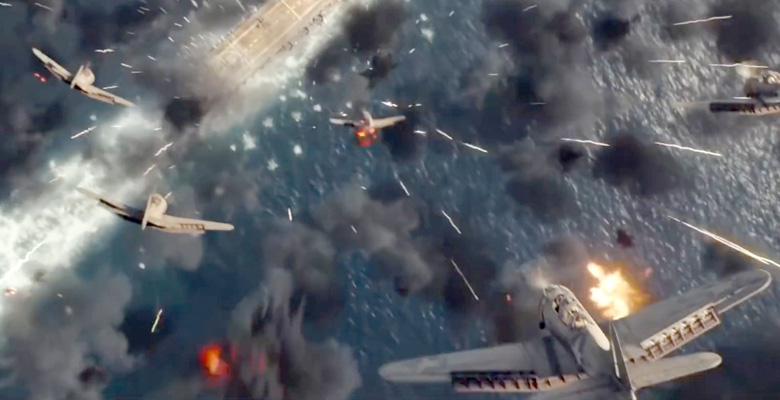The movie “Midway” is excellent, but with a few caveats
by Edward Ulrich, November 13, 2019

The other day I read about the “Midway” movie which is playing in theaters that shows what happened during the Battle of Midway during World War II, and upon hearing about it I decided to watch a documentary about the conflict because I knew almost nothing about it, and after watching the documentary I decided to see the movie.
The Battle of Midway was an attack by Japanese forces on a small island in the Pacific that the U.S. was using as a naval base. The Japanese were hoping for a surprise attack, however the U.S. knew about it in advance which enabled them to prepare for it. The battles which ensued were extreme to the point of being surreal, consisting of aerial dogfights with heavy casualties, and it resulted in the Japanese losing much of their navy at the end of the fighting.
The special effects in the movie are quite good, being created by Roland Emmerich, who made the “Independence Day” movie. Interestingly though, I think a few of the effects in scenes featured in the trailer seem to me to appear to be somewhat “sub-par” in quality (simply because they are not motion-blurred enough?), however it turned out that the supposed lackluster quality of those few scenes is not indicative of the overall quality of the effects in the movie. Due to the issues with the trailer I went into the movie assuming that the filmmakers somehow took shortcuts with the special effects for whatever reason; however I ended up being very impressed by the excellent quality of the effects instead.
I think the biggest flaw of the movie is that it attempts to explain the complicated circumstances of the battles by trying to accommodate the information entirely in its story, instead of also interspersing documentary-style explanations using graphics and voiceovers such as the documentaries do that are embedded later in this article— with the result being that key information too often ends up slipping past the viewers (and in many cases important information is not even mentioned at all)— which I think can result in the movie being perceived too much as simply “just another outrageous shoot-em-up spectacle” with its viewers not adequately being made to understand the very interesting strategic significance of what was happening. I also think the inclusion of interspersed narration would have served as a reminder that the extraordinarily surreal and almost sci-fi—seeming battle scenes in the movie actually did happen in reality, and that they happened almost eighty years ago. Therefore I think it is very important to watch both of the following documentaries about the conflict that are contained on this page before watching the actual movie.
Expanding on what I’m talking about in the preceding paragraph, I think the movie’s lack of supplying documentary information explaining what was happening during the battles is often responsible for it receiving negative or lukewarm reviews by critics as not being a “serious” movie, for example a prominently displayed review on the “Rotten Tomatoes” website summed it up as “history buffs need not apply”, despite the fact that the battles in the movie were historically accurate. Apparently many critics simply assumed that the movie must have been embellished and exaggerated, not realizing that the real battles being recreated actually did resemble a typical “over the top action movie”.
A Summary of the Midway Attacks
— In June, 1942, the United States had advanced knowledge of a large Japanese surprise attack on the Midway Atoll which is about 1,200 miles to the west of the Hawaiian Islands. The Americans had the information due to having access to some Japanese cyphers combined with the use of deductive reasoning. They knew they attack was coming but they did not know specifically when.
— The Japanese had too much confidence that their attack on Midway Island would be a surprise, resulting in their not searching the surrounding waters adequately enough for American aircraft carriers which were hiding and waiting to launch counter-attacks on the attacking Japanese navy. The Japanese also did not have radar technology, which the Americans did.
— Once the Japanese launched their planes against Midway Island in what they thought was a surprise attack, the Americans were able to immediately scramble all of their planes on the island which left none of them as targets on the ground, allowing the Japanese to only cause damage to some buildings such as empty aircraft hangars and an oil depot, leaving the important runways still functional.
— Immediately after the Japanese attack, their planes returned to their carriers in order to be resupplied for another attack, at which point the Americans then launched continual small waves of air attacks against the aircraft carriers which were essentially suicide missions for the American pilots, and they initially did essentially no damage to the Japanese ships; however the attacks served as a distraction which prevented the Japanese from being able to launch more attacks against the island and against the American carriers once the Japanese eventually found out about their presence, leaving the Japanese carriers laden with their attack planes waiting on their decks with bombs attached to them and with their pilots sitting in their cockpits anxiously waiting to take off.
— Eventually some American dive bomber planes were able to evade the heavy defenses of the Japanese navy, and the few times that they succeeded in dropping bombs on the Japanese carriers they caused catastrophic damage due to the decks being loaded full of waiting planes and bombs which exploded in huge chain reactions, allowing the Americans to destroy all four of Japan’s carriers along with almost all of the experienced Japanese pilots in their navy by dropping only a few small bombs onto each carrier.
— The damage to the Japanese navy was catastrophic, losing all of their aircraft carriers and with over 3,500 Japanese servicemen dying including most of their highly trained and experienced pilots. Only 307 Americans died in the fighting. Most of the Japanese died when their aircraft carriers were sunk, and most of the Americans died performing what were essentially suicide attacks against the Japanese ships.
— In June, 1942, the United States had advanced knowledge of a large Japanese surprise attack on the Midway Atoll which is about 1,200 miles to the west of the Hawaiian Islands. The Americans had the information due to having access to some Japanese cyphers combined with the use of deductive reasoning. They knew they attack was coming but they did not know specifically when.
— The Japanese had too much confidence that their attack on Midway Island would be a surprise, resulting in their not searching the surrounding waters adequately enough for American aircraft carriers which were hiding and waiting to launch counter-attacks on the attacking Japanese navy. The Japanese also did not have radar technology, which the Americans did.
— Once the Japanese launched their planes against Midway Island in what they thought was a surprise attack, the Americans were able to immediately scramble all of their planes on the island which left none of them as targets on the ground, allowing the Japanese to only cause damage to some buildings such as empty aircraft hangars and an oil depot, leaving the important runways still functional.
— Immediately after the Japanese attack, their planes returned to their carriers in order to be resupplied for another attack, at which point the Americans then launched continual small waves of air attacks against the aircraft carriers which were essentially suicide missions for the American pilots, and they initially did essentially no damage to the Japanese ships; however the attacks served as a distraction which prevented the Japanese from being able to launch more attacks against the island and against the American carriers once the Japanese eventually found out about their presence, leaving the Japanese carriers laden with their attack planes waiting on their decks with bombs attached to them and with their pilots sitting in their cockpits anxiously waiting to take off.
— Eventually some American dive bomber planes were able to evade the heavy defenses of the Japanese navy, and the few times that they succeeded in dropping bombs on the Japanese carriers they caused catastrophic damage due to the decks being loaded full of waiting planes and bombs which exploded in huge chain reactions, allowing the Americans to destroy all four of Japan’s carriers along with almost all of the experienced Japanese pilots in their navy by dropping only a few small bombs onto each carrier.
— The damage to the Japanese navy was catastrophic, losing all of their aircraft carriers and with over 3,500 Japanese servicemen dying including most of their highly trained and experienced pilots. Only 307 Americans died in the fighting. Most of the Japanese died when their aircraft carriers were sunk, and most of the Americans died performing what were essentially suicide attacks against the Japanese ships.
“Battlefield” documentary: “The Battle of Midway”
This documentary explains the Pacific naval conflicts between Japan and the US up through the Midway attacks. It starts by explaining Japan’s aggressive military expansion throughout the Pacific including their attack on Pearl Harbor and the “Battle of Coral Sea”, followed by explaining details about the various armaments used in the conflicts such as the types of ships and airplanes used by the Japanese and Americans, and then it explains the Midway attacks in detail.
NOTE: At about one hour and eight minutes into this documentary (over halfway into the video), it starts to specifically detail the Midway attacks. This is a good place to start watching if you don’t want to initially watch the entire documentary.
This documentary explains the Pacific naval conflicts between Japan and the US up through the Midway attacks. It starts by explaining Japan’s aggressive military expansion throughout the Pacific including their attack on Pearl Harbor and the “Battle of Coral Sea”, followed by explaining details about the various armaments used in the conflicts such as the types of ships and airplanes used by the Japanese and Americans, and then it explains the Midway attacks in detail.
NOTE: At about one hour and eight minutes into this documentary (over halfway into the video), it starts to specifically detail the Midway attacks. This is a good place to start watching if you don’t want to initially watch the entire documentary.
“The Battle of Midway 1942: Told from the Japanese Perspective”
This well-made documentary is a detailed explanation of what happened in the Midway attacks by making use of animated maps with narration.
(Note the video clip is titled as being “one of two”, however I was not able to find the second video in the series. Nonetheless this video explains information about the Midway attacks almost in their entirety.)
This well-made documentary is a detailed explanation of what happened in the Midway attacks by making use of animated maps with narration.
(Note the video clip is titled as being “one of two”, however I was not able to find the second video in the series. Nonetheless this video explains information about the Midway attacks almost in their entirety.)





















